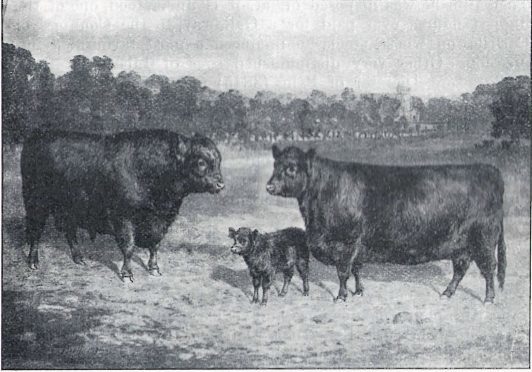Next month the World Galloway Cattle Congress comes home to Scotland – the birthplace of the wider “Galloway Family” and the breed which is famed for its hardiness and quality of beef.
The World Galloway Cattle Congress recognises all Galloway types in the family – white, belted, riggit and the more popular blacks.
Their origins lie in Wigtownshire, the Stewartry of Kirkcudbright and parts of Dumfriesshire and south Ayrshire, roughly west of the Tweed and south of the Clyde. Cattle breeding in the area goes back to the 1100s with evidence of polled cattle being driven into England in the 1600s.
Droving became big business and by the late 18th century droves of 30,000 headed south to East Anglia.
Cattle were traded at the Rood Fair in Dumfries and subsequently some 20,000 beasts passed through the toll and over the River Nith in 10 days. It is also thought that the Red Poll breed that came out of Norfolk and Suffolk came about as a result of polled red Galloway bulls being put to local cattle.
The arrival of the railways ended droving meaning faster transport for perishables like milk. This led to an influx of dairying, pushing the Galloways into the hills to become famed for producing good beef calves in harsh conditions. Despite the animal’s beef credentials there is evidence of Galloway herds being milked in Cumberland for cheese with the calves fed the whey.
The exact origins of white Galloway cattle is unknown while the Beltie’s may have arisen with the use of belted Dutch cattle in the 17th century.
The rigget type, which are given that name because of the white stripe running along the spine, are thought to have been common place until the widespread use of crossing the blacks with white Shorthorns to produce the respected Blue Greys.
This no doubt had a factor in the black Galloways becoming the more popular and here we follow their history.
Records of Black Galloway cattle, although duns and brindles are accepted, were initially kept in the Polled Cattle Herd Book.
Kept in Banffshire it was more centred on what was to become the Aberdeen-Angus.
The Galloway strained animals were listed separately and thus lineage could be traced.
It was privately owned and because of differences of the two breed types negotiations by south-west agriculturalist Mr Maxwell, of the Munches, took place with £75 paid for the Galloway part from the publisher.
Compiling the first herd book was the Reverend Dr John Gillespie who had to piece it together after the 1851 fire in the HASS museum destroyed the first Polled Herd Book. He then became the first secretary of the society in 1877.
The first Galloway Show was staged in Lockerbie in 1851 under the auspices of the Lockerbie Farmers Club. The event included a sale which led to the founding of the Galloway Agricultural Society in 1855 and the staging of the first Castle Douglas Galloway sale. By 1855 Castle Douglas had become the most popular sale venue and today the sales are still held at Wallets Marts.
The British Galloway Society was formed in 1908 after some controversy with more occurring in 1912 when it was decided to ban Dun Galloways because of objections by American breeders and the Smithfield Show, however the ban was later lifted.
The society presented the Dr Gillespie Memorial trophy to the Highland Show, following his death in 1912. In 1923 Galloways took the supreme carcase championship at Smithfield for the third year running.
World War II saw a cessation of shows with only Castle Douglas and Ballymena remaining. However the post war era saw a substantial rise in the numbers because of the 1947 hill cow subsidies.
There were good attendances at the 40-odd shows with Galloway classes during the 1960s with a Smithfield Championship in 1964.
TB eradication schemes were established but in 1967 foot-and-mouth disease affected sales and exports, and the later 2001 outbreak had a more lasting effect.
In 1970 changes to the herd book were introduced and copies were given to the Ayrshire Society for safe keeping in the event of fire. Although continental cattle imports were on the increase it was still a healthy period with the Queen forming a herd at Balmoral.
The centenary in 1977 was marked with visits to leading herds in the south-west. It also saw the first exports to Germany which developed further during the 1980s until the BSE crisis outwith Galloway cattle caused an export ban in 1990.
Such had been the German demand and the resulting paperwork following the Castle Douglas sales, Wallets laid on a special room to process the documentation known as the Bundesbank.
